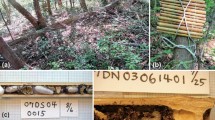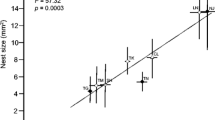Summary
InStegodyphus sarasinorum Karsch the adult stage is attained after twelve instars. The secondary sexual characters become manifest in the twelfth instar. There is only one generation per year. Normally only one cocoon is made and taken care of by a fertilized female during her life-time.
The various aspects of the bionomics and behaviour of this social spider, viz., the nest architecture, repair of webs, activity rhythm, food and feeding behaviour, population density at different stages, sex-ratio, sexual behaviour, maternal behaviour, dispersal and colony foundation, are discussed. Besides feeding her young ones during the second instar by regurgitation and by providing them with captured prey, the mother spider finally offers herself as a living food depot for her young ones which suck out her body fluids and she slowly dies.
New colonies are formed after emigration over silken threads by either groups of spiderlings at various times in colonies during the fourth to ninth instars (sociotomy), or by individual fertilized females. In a second method of colony foundation, emigration of spiderlings of fourth to eighth instars takes place either by individuals or by small groups by means of silken threads produced and wafted in the wind (aerial navigation).
Résumé
ChezStegodyphus sarasinorum Karsh, l'état adulte est atteint après 12 stades. Les caractères sexuels secondaires deviennent visibles au douzième. Il y a seulement une génération par an. Normalement, durant sa vie, une femelle ne tisse et soigne qu'un seul cocon.
On a analysé les différents aspects de la bionomie et du comportement de cette araignée sociale, c'est-à-dire l'architecture du nid, réparation de la toile, rythme d'activité, nourriture et comportement alimentaire, densité de population aux différents stades, sex-ratio, comportement sexuel, comportement maternel, dispersion et fondation de colonies. En plus du nourrissage de ses enfants au deuxième stade par régurgitation et apport de proies capturées, la mère s'offre finalement comme réserve vivante de nourriture pour ses enfants qui pompent la lymphe et elle meurt lentement.
De nouvelles colonies apparaissent par migration sur fils de soie ou bien de jeunes du quatrième au neuvième stade à différents moments de la colonie, ou bien de femelles fécondées seules. Dans une deuxième méthode de fondation de colonie, la migration des jeunes du quatrième au huitième stade se fait seule ou en petits groupes par production de fils de soie et transport aérien.
Similar content being viewed by others
References
Bradoo (B. L.), 1972. — Some observations on the Ecology of Social spiderStegodyphus sarasinorum Karsch (Araneae: Eresidae) from India.Oriental Ins., 6 (2), 193–204.
Bristowe (W. S.), 1958. — The World of Spiders, 60–61. Collins Clear-type Press, London.
Cambridge (O. P.), 1889. —Proc. Zool. Soc. London., 42–44.
Comstock (J. H.), 1949. — The Spider Book, 215–216. Comstock Publishing Co. Inc., Ithaca, N.Y.
Duffey (E.), 1956. — (Nature Conserv., Norwich, Norfolk) Aerial dispersal in a known Spider population.Jour. Animal Ecol., 25, (1), 85–111.
Emerton (J. H.), 1919. — The flight of spiders in the autumn of 1918.Ent. News., 30, 165–168.
Grassé (P. P.) andNoirot (C. H.), 1951. — La sociotomie: migration et fragmentation de la termitière chez lesAnoplotermes et lesTrinervitermes.Behaviour, 3, 146–166.
Jambunathan (N. S.), 1903. — The habits and life-history of a social spider (Stegodyphus sarasinorum Karsch.),Smiths. Misc. Coll., 47, 365–372.
Kullmann (E.), 1972. — Evolution of Social Behaviour in Spiders (Araneae; Eresidae and Theridiidae).Am. Zoologist, 12, 419–426.
Kullmann (E.) andKloft (W.), 1968. — Tracerunter-suchungen zur Regurgitationsfutterung bei Spinnen (Araneae, Theridiidae).Zool. Anz., 32, (suppl.), 487–497.
Phanuel (G. J.), 1960. — Unusual Nest-site of the Social SpiderStegodyphus sarasinorum Karsch.J. Bombay nat. Hist. Soc., 57 (3), 686–688.
Savory (T.), 1964. — Arachnida, 69–74, Academic Press, London.
Subrahmanyan (T. V.), 1953. — On the habits of Indian Eresid spidersStegodyphus sarasinorum Karsch.J. Bombay nat. His. Soc., 51, 521–522.
Walcott (C.) andVan der Kloot (W. G.), 1959. — The physiology of the spider vibration receptor.J. Exp. Zool., 141, 191–244.
Author information
Authors and Affiliations
Rights and permissions
About this article
Cite this article
Jacson, C.C., Joseph, K.J. Life-history, bionomics and behaviour of the social spiderStegodyphus sarasinorum Karsch. Ins. Soc 20, 189–203 (1973). https://doi.org/10.1007/BF02223347
Issue Date:
DOI: https://doi.org/10.1007/BF02223347




